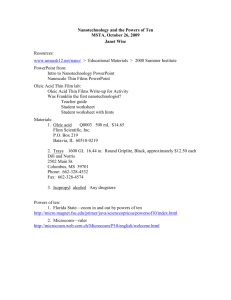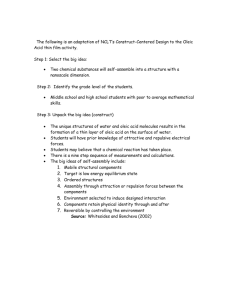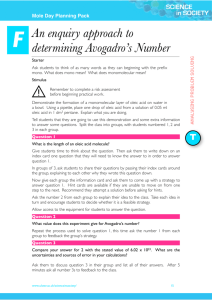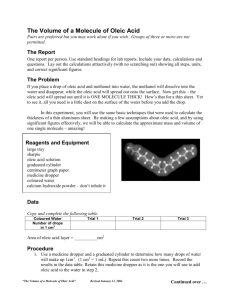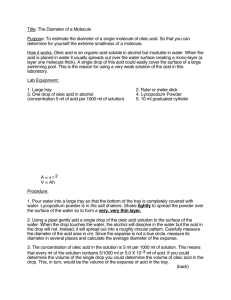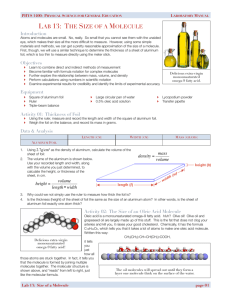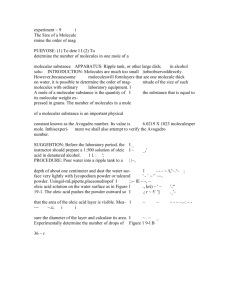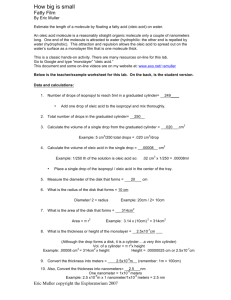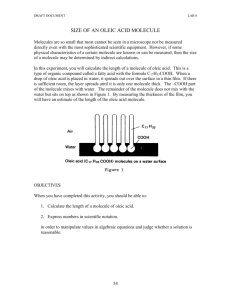Oleic Acid Molecule Size: Lab Experiment
advertisement
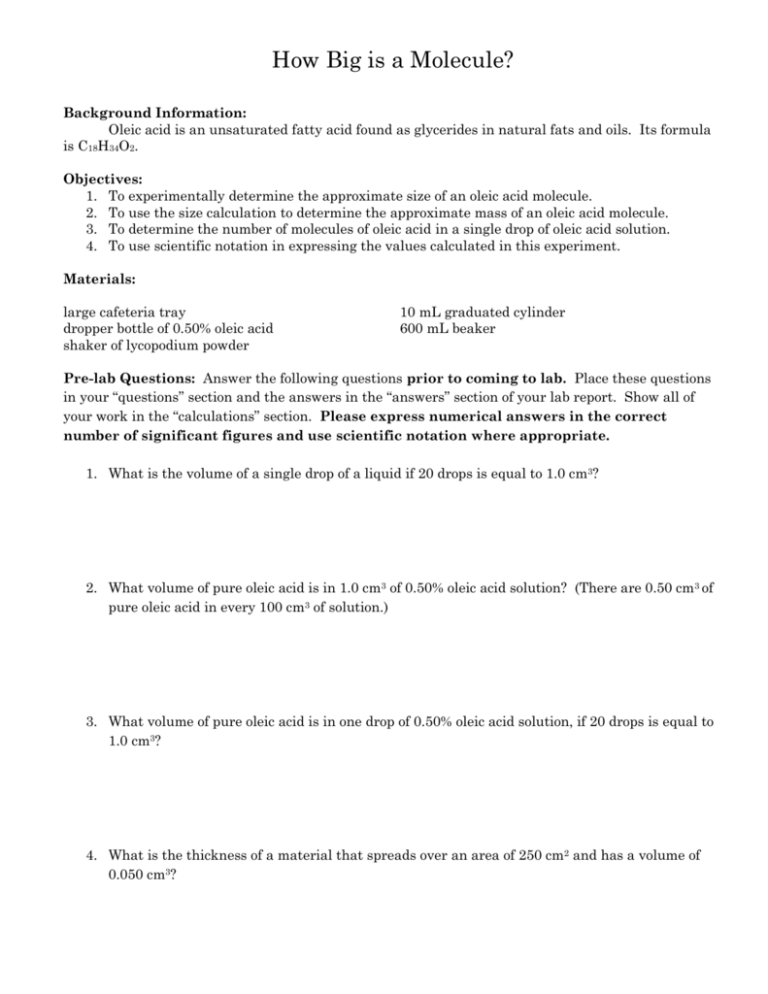
How Big is a Molecule? Background Information: Oleic acid is an unsaturated fatty acid found as glycerides in natural fats and oils. Its formula is C18H34O2. Objectives: 1. To experimentally determine the approximate size of an oleic acid molecule. 2. To use the size calculation to determine the approximate mass of an oleic acid molecule. 3. To determine the number of molecules of oleic acid in a single drop of oleic acid solution. 4. To use scientific notation in expressing the values calculated in this experiment. Materials: large cafeteria tray dropper bottle of 0.50% oleic acid shaker of lycopodium powder 10 mL graduated cylinder 600 mL beaker Pre-lab Questions: Answer the following questions prior to coming to lab. Place these questions in your “questions” section and the answers in the “answers” section of your lab report. Show all of your work in the “calculations” section. Please express numerical answers in the correct number of significant figures and use scientific notation where appropriate. 1. What is the volume of a single drop of a liquid if 20 drops is equal to 1.0 cm3? 2. What volume of pure oleic acid is in 1.0 cm3 of 0.50% oleic acid solution? (There are 0.50 cm3 of pure oleic acid in every 100 cm3 of solution.) 3. What volume of pure oleic acid is in one drop of 0.50% oleic acid solution, if 20 drops is equal to 1.0 cm3? 4. What is the thickness of a material that spreads over an area of 250 cm2 and has a volume of 0.050 cm3? Procedure: 1. Obtain a 10 mL graduated cylinder and a dropper bottle of 0.50% oleic acid solution in ethanol. 2. Using the dropper in the oleic acid bottle, count the number of drops of oleic acid solution needed to fill a volume of 1.0 cm3 in the graduated cylinder. Record the number in Data table 2. 3. Continue counting the number of drops of ethanol to 2.0 cm3. Record the number of drops in the second cubic centimeter. (remember that 1 cm3 = 1 mL) 4. Continue counting the number of drops of ethanol to 3.0 cm3. Record the number of drops in the third cubic centimeter. 5. Obtain a cafeteria tray. Clean the tray with Alconox. Rinse three times. Dry the tray. 6. Add cold tap water to the tray until it is half full. Allow the surface of the water to become still. 7. Dust the surface of the water with a fine coating of lycopodium powder. You will find the powder in salt shakers. 8. Carefully deposit one drop of the oleic acid solution in the center of the lycopodium powder. The circle generated should contract slightly as the ethanol dissolves in the water and evaporates. 9. Quickly measure the diameter of the circle in three (3) spots. Record in Data table 1. 10. Calculate the average diameter of the circle for each trial. 11. Clean the cafeteria tray as in step 5, and repeat steps 6-10 for a total of three trials. Data: Data Table 1 1st Diameter (cm) Diameter of the Circle 2nd Diameter (cm) 3rd Diameter (cm) Average Diameter (cm) Average Diameter (cm) Trial 1 Trial 2 Trial 3 Data Table 2 # drops in 1 cm3 Trial 1 Trial 2 Trial 3 Post Lab Questions: 1. Calculate the average number of drops in 1.0 cm3. (Remember 1 cm3 = 1.0 mL) 2. Calculate the volume of one drop of liquid. Express your answer in scientific notation. 3. Calculate the volume of pure oleic acid in one drop of 0.50% oleic acid solution. Express your answer in scientific notation. 4. Calculate the area and determine the average area for your three trials. Area = Π r2 5. Calculate the thickness of one molecule of oleic acid by dividing the volume calculated in question 3 by the average area calculated in question 4. Express your answer in scientific notation. 6. Calculate the volume of one molecule, assuming that the length and width are each one tenth of the thickness. Express your answer in scientific notation. 7. Calculate the mass of one molecule of oleic acid by multiplying the volume by the density, which is 0.895 g/cm3. Express your answer in scientific notation. 8. Compare your answers with others in the class. Place your data on the board in the appropriate columns. How close are the values? Group # Thickness (cm) Volume (cm3) Mass (g) 9. Do you think an atom will be bigger or smaller than the value that you calculated for the size of an oleic acid molecule? Explain. 10. Approximately how many molecules of oleic acid were in the drop of oleic acid solution? Remember that you know the volume of one molecule and you know the total volume of pure oleic acid that you used. 11. Using the values you obtained for the thickness, what area would be covered if 10 cubic centimeters of pure oleic acid were spread over a large body of water? What is the area in square kilometers? Conclusion:
